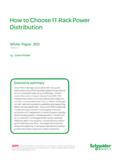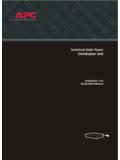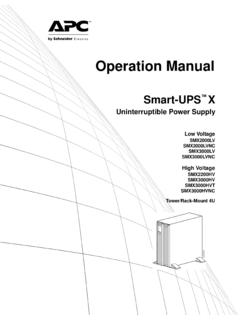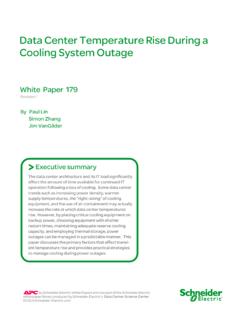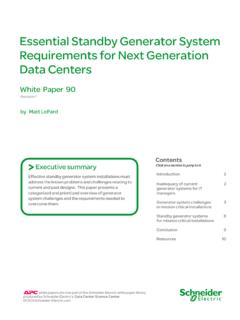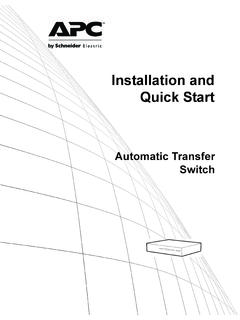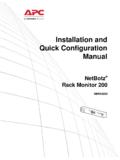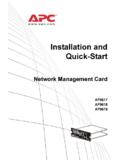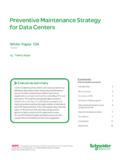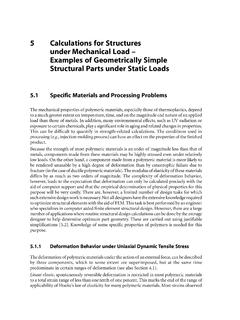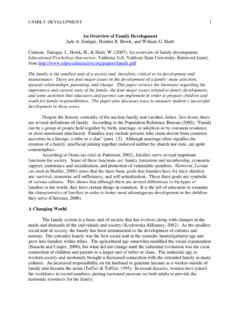Transcription of Monitoring Physical Threats - - APC USA
1 Monitoring Physical Threats in the Data Center Revision 3 by christian Cowan and Chris Gaskins Introduction 2 What are distributed Physical Threats ? 2 Sensor placement 5 Aggregating sensor data8 Intelligent action 8 Design method 11 Sample sensor layout12 Conclusion 12 Resources 13 Click on a section to jump to it Contents White Paper 102 Traditional methodologies for Monitoring the data center environment are no longer sufficient. With technologies such as blade servers driving up cooling demands and regulations such as Sarbanes-Oxley driving up data security requirements, the Physical environment in the data center must be watched more closely.
2 While well understood protocols exist for Monitoring Physical devices such as UPS systems, computer room air conditioners, and fire suppression systems, there is a class of distributed Monitoring points that is often ignored. This paper describes this class of Threats , suggests approaches to deploying Monitoring devices, and provides best practices in leveraging the collected data to reduce downtime. Executive summary> white papers are now part of the Schneider Electric white paper libraryproduced by Schneider Electric s Data Center Science Center Monitoring Physical Threats in the Data Center Schneider Electric Data Center Science Center White Paper 102 Rev 3 2 Today s common techniques for Monitoring the data center environment date from the days of centralized mainframes, and include such practices as walking around with thermometers and relying on IT personnel to feel the environment of the room.
3 But as data centers continue to evolve with distributed processing and server technologies that are driving up power and cooling demands, the environment must be looked at more closely. Rising power density and dynamic power variations are the two main drivers forcing changes in the Monitoring methodology of IT environments. Blade servers have tremendously increased power densities and dramatically changed the power and cooling dynamics of the surrounding environments. Power management technologies have pushed the ability of servers and communication equipment to vary power draw (and therefore heat dissipation) based on computational load. This issue is described in detail in White Paper 43, Dynamic Power Variations in Data Centers and Network Rooms. Although it is common to have sophisticated Monitoring and alerting capabilities in Physical equipment such as the uninterruptible power supply (UPS), computer room air conditioner (CRAC), and fire suppression systems, other aspects of the Physical environment are often ignored.
4 Monitoring of equipment is not enough the surrounding environment must be viewed holistically and watched proactively for Threats and intrusions. Such Threats include excessive server intake temperatures, water leaks, and unauthorized human access to the data center or inappropriate actions by personnel in the data center. Remote network locations such as branch offices, network closets, and local point-of-sale locations further highlight the need for automated Monitoring , where it is impractical and unreliable to have people physically present to check conditions such as temperature and humidity. With the introduction of unmanned network outposts, IT administrators must have reliable systems in place to know what is going on. With today s technologies, Monitoring systems can be configured to a level of detail that meets the data center s particular environmental and security demands each rack can be considered a mini data center with its own requirements, with a Monitoring strategy that may include multiple data collection points.
5 This paper discusses Physical Threats that can be mitigated by distributed Monitoring strategies, and offers guidelines and best practices for implementing sensors in the data center. It also discusses the use of data center design tools to simplify the specification and design process of these distributed Monitoring systems. This paper addresses a subset of Threats distributed Physical Threats that are of particular interest because they require deliberate and expert design to defend against them. To identify that subset, it will be helpful to briefly characterize the range of Threats to the data center. Data center Threats can be classified into two broad categories, depending on whether they are in the realm of IT software and networking (digital Threats ) or in the realm of the data center s Physical support infrastructure ( Physical Threats ).
6 Introduction Dynamic Power Variations in Data Centers and Network Rooms Related resource White Paper 43 What are distributed Physical Threats ? Monitoring Physical Threats in the Data Center Schneider Electric Data Center Science Center White Paper 102 Rev 3 3 Digital Threats Digital Threats are such things as hackers, viruses, network bottlenecks, and other accidental or malicious assaults on the security or flow of data. Digital Threats have a high profile in the industry and the press, and most data centers have robust and actively maintained systems, such as firewalls and virus checkers, to defend against them. White Paper 101, Fundamental Principles of Network Security, reviews the basic safeguards against digital Threats . Digital Threats are not the subject of this paper.
7 Physical Threats Physical Threats to IT equipment include such things as power and cooling problems, human error or malice, fire, leaks, and air quality. Some of these, including Threats related to power and some related to cooling and fire are routinely monitored by built-in capabilities of power, cooling, and fire suppression devices. For example, UPS systems monitor power quality, load, and battery health; PDUs monitor circuit loads; cooling units monitor input and output temperatures and filter status; fire suppression systems the ones that are required by building codes monitor the presence of smoke or heat. Such Monitoring typically follows well understood protocols automated by software systems that aggregate, log, interpret, and display the information. Threats monitored in this way, by pre-engineered functionality designed into the equipment, do not require any special user expertise or planning in order to be effectively managed, as long as the Monitoring and interpretation systems are well engineered.
8 These automatically-monitored Physical Threats are a critical part of a compre-hensive management system, but are not the subject of this paper. However, certain kinds of Physical Threats in the data center and they are serious ones do not present the user with pre-designed, built-in Monitoring solutions. For example, the threat of poor humidity levels can be anywhere in the data center, so the number and placement of humidity sensors is an important consideration in managing that threat. Such Threats can potentially be distributed anywhere throughout the data center, at variable locations that are particular to room layout and equipment positioning. The distributed Physical Threats covered by this paper fall into these general categories: Air quality Threats to IT equipment (temperature, humidity) Liquid leaks Human presence or unusual activity Air quality Threats to personnel (foreign airborne substances) Smoke and fire from data center hazards1 Figure 1 illustrates the distinction between digital and Physical Threats , and the further distinction in Physical Threats between those with pre-engineered equipment-based pow-er/cooling Monitoring and the subject of this paper distributed Physical Threats that require assessment, decisions, and planning to determine the type, location, and number of monitor-ing sensors.
9 It is this latter type of Physical threat that may risk neglect because of lack of knowledge and expertise in designing an effective Monitoring strategy. 1 Basic room smoke/fire detection required by building codes is governed by specific legal and safety regulations, and is not the subject of this paper. This paper covers supplemental smoke detection particular to hazards in the data center, beyond what is required by building codes. Fundamental Principles of Network Security Related resource White Paper 101 Monitoring Physical Threats in the Data Center Schneider Electric Data Center Science Center White Paper 102 Rev 3 4 Table 1 summarizes distributed Physical Threats , their impact on the data center, and the types of sensors used to monitor them.
10 Figure 1 Threats to the data center Monitoring Physical Threats in the Data Center Schneider Electric Data Center Science Center White Paper 102 Rev 3 5 Threat Definition Impact on data center Types of sensors Air temperature Room, rack, and equipment air temperature Equipment failure and reduced equipment life span from temperature above specification and/or drastic temperature changes Temperature sensors Humidity Room and rack relative humidity at specific temperature Equipment failure from static electricity buildup at low humidity points Condensation formation at high humidity points Humidity sensors Liquid leaks Water or coolant leaks Liquid damage to floors, cabling and equipment Indication of CRAC problems Rope leak sensors Spot leak sensors Human error and personnel access Unintentional wrongdoing by personnel Unauthorized and/or forced entry into the data center with malicious intent Equipment damage and data loss Equipment downtime Theft and sabotage of equipment Digital video cameras Motion sensors Door contacts Glass-break sensors Vibration sensors Smoke / Fire Electrical or material fire Equipment failure Loss of assets and data Supplemental smoke sensors Hazardous airborne contaminants Airborne chemicals such as hydrogen from batteries and particles such as dust Dangerous situation for personnel and/or UPS unreliability and failure from release of hydrogen Equipment failure from increased static electricity and clogging of filters/fans from dust buildup Chemical /
